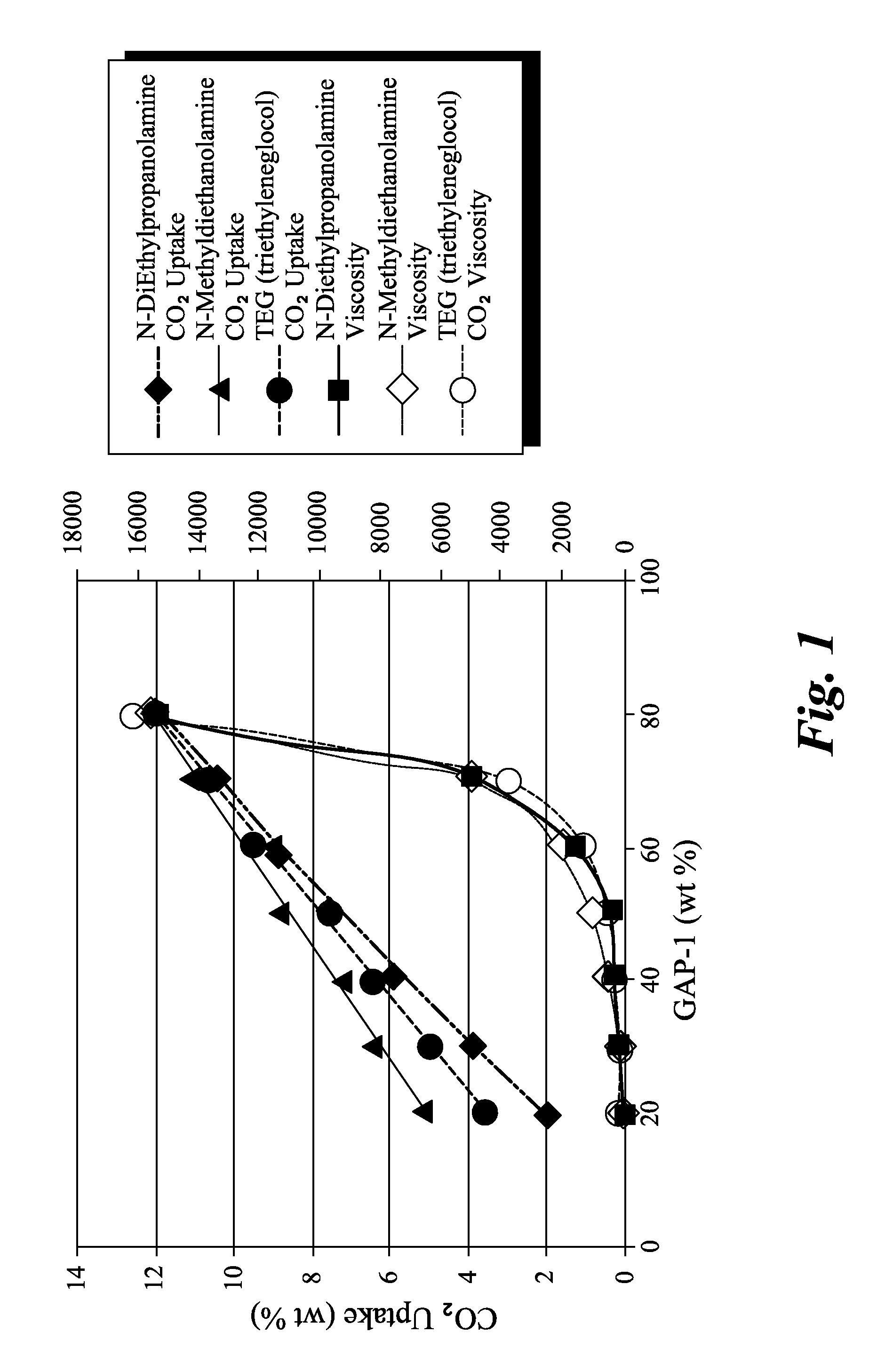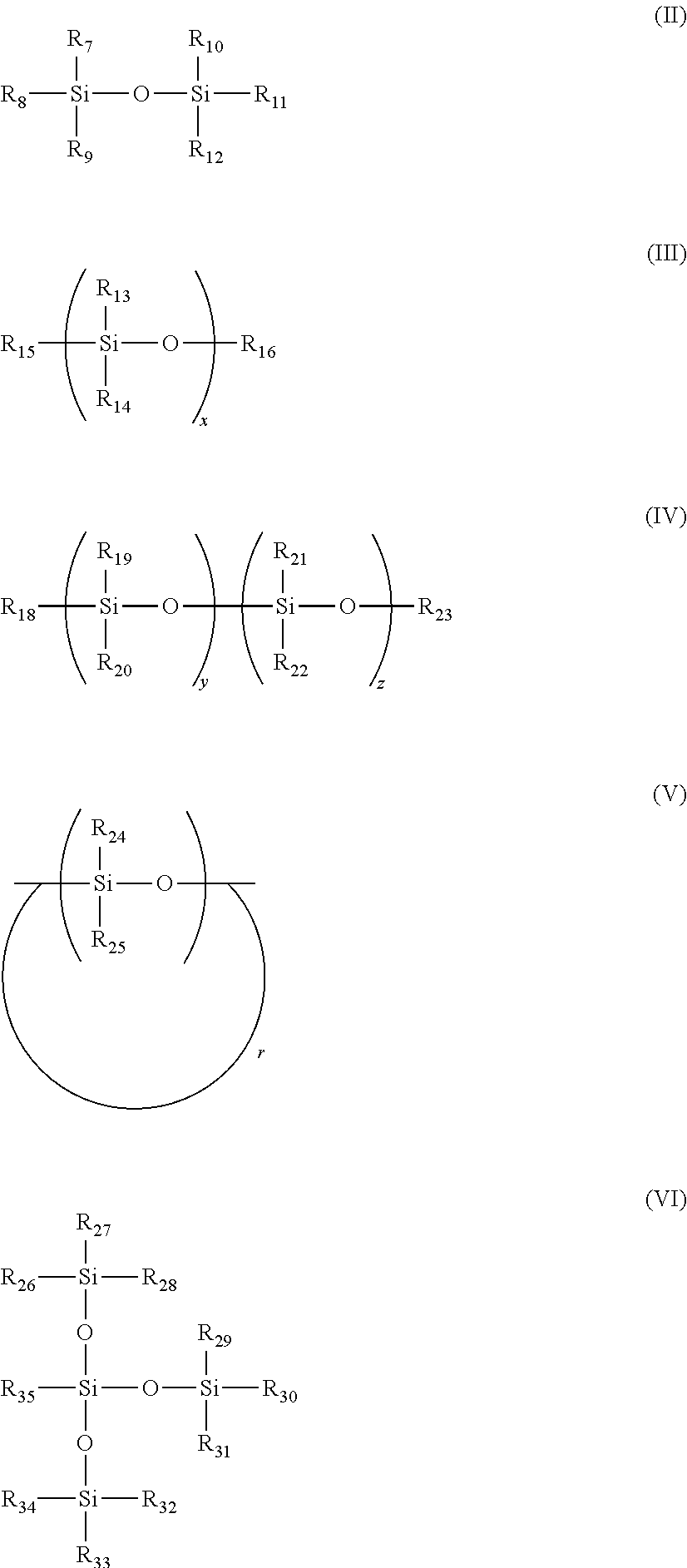Compositions for absorbing carbon dioxide, and related processes and systems
a carbon dioxide and carbon dioxide technology, applied in the field of carbon dioxide capture processes, can solve the problems of clogging of pipelines, wider adoption of this type of technology, and sharp increases in the viscosity of liquid absorbents
- Summary
- Abstract
- Description
- Claims
- Application Information
AI Technical Summary
Benefits of technology
Problems solved by technology
Method used
Image
Examples
example 1
Synthesis of 1,3-bis(3-(2-aminoethyl)aminopropyl)-1,1,3,3-tetramethyldisiloxane (Entry 27 in Table 4, below)
[0071]Ethylenediamine (155 g, 2.58 moles) was charged to a 500 mL three-necked flask equipped with a magnetic stir bar, reflux condenser, addition funnel, and nitrogen sweep. The amine material was then heated, using an oil bath. Once the temperature reached about 95° C., 1,3-bis(3-chloropropyl)-1,1,3,3-tetramethyldisiloxane (73 g, 254 mmols) was added drop-wise over about 2 hours. During this time. the temperature of the oil bath was allowed to increase to about 110-115° C. Once addition was complete, the reaction mixture was allowed to continue at this temperature for 2 more hours, at which time proton NMR readings indicated that the reaction was complete.
[0072]The mixture was then cooled, and some of the excess ethylene diamine was stripped off. At this point, the material was cooled to room temperature, and partitioned between chloroform and 10% NaOH. The organic phase was...
example 2
Synthesis of tris(3-aminopropyldimethylsiloxy)-3-aminopropylsilane (M′3T′) (Entry 29 in Table 4, below)
[0073]42.1 g of GAP-0 (0.339 mols M′) was mixed with 25.0 g 3-aminopropyltriethoxysilane (0.113 mols), and 0.65 g of tetramethylammonium hydroxidepentahydrate. The solution was heated at 60° C. (under N2) for an hour, and then 6.8 mL of water were added. Heating was then continued up to 90-95° C. 70 mL toluene was added, and after another hour a vacuum was applied and the toluene as well as water, and ethanol were stripped off. Once solvent stripping was complete, NMR showed the ethoxy groups to be essentially gone. Heating was continued overnight to ensure the reaction was at equilibrium. Then, the mixture was further heated and stripped as above (i.e. house vacuum, strip up to 165° C.). On cooling to room temperature, 53.8 g of material (98.5% yield) was obtained as a light yellow oil. 1H NMR (CDCl3) d 2.60 (t, J=6, 8H, CH2NH2), 1.39 (m, 8H, CH2CH2CH2), 1.04 (br. s., 8H, NH2), 0....
example 3
Synthesis of 1,5-bis(3-aminopropyl)-1,1,3,3,5,5-hexamethyltrisiloxane (sometimes referred to as “GAP-1”, entry 25 in Table 4, below)
[0074]20.0 g of GAP-0 (0.0805 mols) was mixed with 6.0 g D4 (0.0805 mols D) and 0.15 g of tetramethyl-ammoniumhydroxide pentahydrate. The mixture was heated to ca. 40° C. under vacuum for an hour to remove some of the water from the catalyst. Next, a nitrogen atmosphere was established, and the temperature was increased to 90-95° C., and allowed to react overnight. The reaction mixture was then heated to 150° C. for 30 minutes. A vacuum was then carefully applied (house vacuum). Heating was then continued to 165° C., and the most volatiles species were stripped off. After cooling, ca. 25 g of product (96% yield) was obtained as a light yellow oil. 1H NMR (CDCl3) d 2.60 (t, J=6, 4H, CH2NH2), 1.39 (m, 4H, CH2CH2CH2), 1.03 (br. s., 4H, NH2), 0.45 (m, 4H, CH2Si), 0.05 to −0.06 (m, 18.6H, CH3Si).
PUM
| Property | Measurement | Unit |
|---|---|---|
| boiling point | aaaaa | aaaaa |
| viscosity | aaaaa | aaaaa |
| temperature | aaaaa | aaaaa |
Abstract
Description
Claims
Application Information
 Login to View More
Login to View More - R&D
- Intellectual Property
- Life Sciences
- Materials
- Tech Scout
- Unparalleled Data Quality
- Higher Quality Content
- 60% Fewer Hallucinations
Browse by: Latest US Patents, China's latest patents, Technical Efficacy Thesaurus, Application Domain, Technology Topic, Popular Technical Reports.
© 2025 PatSnap. All rights reserved.Legal|Privacy policy|Modern Slavery Act Transparency Statement|Sitemap|About US| Contact US: help@patsnap.com



